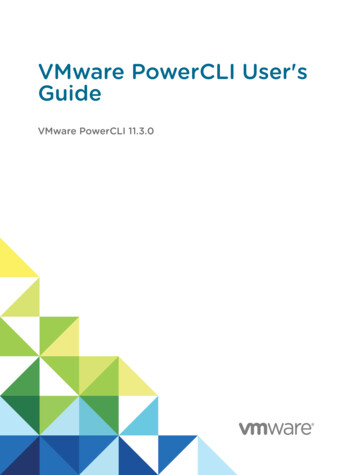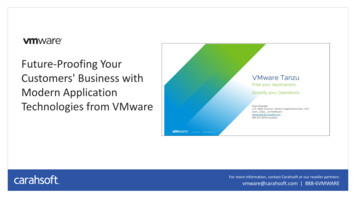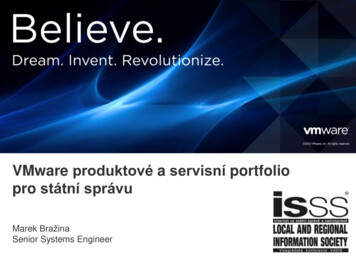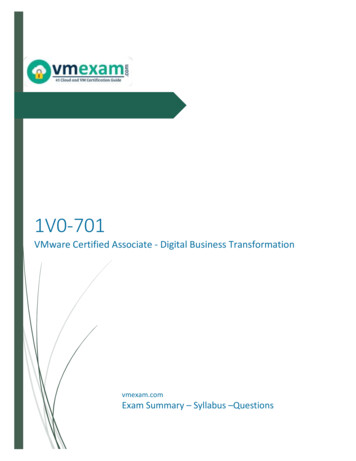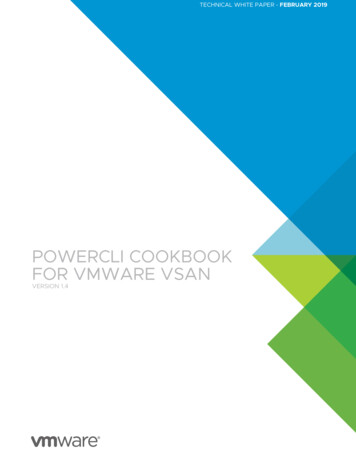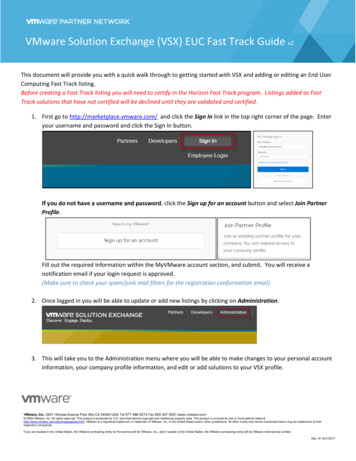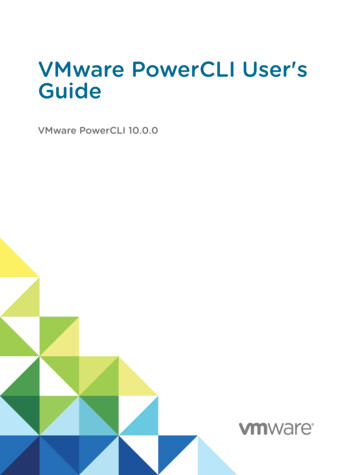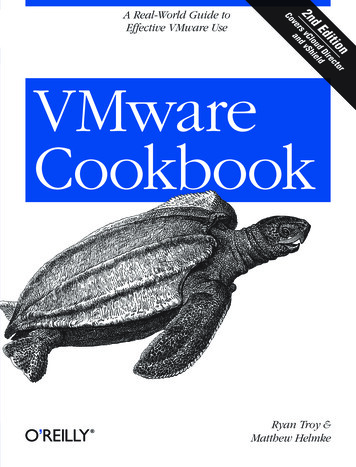
Transcription
SECOND EDITIONVMware CookbookRyan Troy and Matthew HelmkeBeijing Cambridge Farnham Köln Sebastopol Tokyo
VMware Cookbook, Second Editionby Ryan Troy and Matthew HelmkeCopyright 2012 Ryan Troy, Matthew Helmke. All rights reserved.Printed in the United States of America.Published by O’Reilly Media, Inc., 1005 Gravenstein Highway North, Sebastopol, CA 95472.O’Reilly books may be purchased for educational, business, or sales promotional use. Online editionsare also available for most titles (http://my.safaribooksonline.com). For more information, contact ourcorporate/institutional sales department: 800-998-9938 or corporate@oreilly.com.Editor: Andy OramProduction Editor: Rachel SteelyCopyeditor: Absolute Service, Inc.Proofreader: Absolute Service, Inc.June 2012:Indexer: BIM Publishing ServicesCover Designer: Karen MontgomeryInterior Designer: David FutatoIllustrators: Robert Romano and Rebecca DemarestSecond Edition.Revision History for the Second Edition:2012-06-06First release2012-12-14Second releaseSee http://oreilly.com/catalog/errata.csp?isbn 9781449314477 for release details.Nutshell Handbook, the Nutshell Handbook logo, and the O’Reilly logo are registered trademarks ofO’Reilly Media, Inc. VMware Cookbook, the image of a leatherback sea turtle, and related trade dressare trademarks of O’Reilly Media, Inc.Many of the designations used by manufacturers and sellers to distinguish their products are claimed astrademarks. Where those designations appear in this book, and O’Reilly Media, Inc., was aware of atrademark claim, the designations have been printed in caps or initial caps.While every precaution has been taken in the preparation of this book, the publisher and authors assumeno responsibility for errors or omissions, or for damages resulting from the use of the information contained herein.ISBN: 978-1-449-31447-7[LSI]1355331788
Table of ContentsPreface . . . . . . . . . . . . . . . . . . . . . . . . . . . . . . . . . . . . . . . . . . . . . . . . . . . . . . . . . . . . . . . . . . . . . ix1. VMware Infrastructure Installation . . . . . . . . . . . . . . . . . . . . . . . . . . . . . . . . . . . . . . . . at Is VMware Infrastructure 5?What Is VMware vSphere 5.0?Convergence from ESX to ESXi with vSphere 5.0VMware ESXi 5.0 Configuration MaximumsVMware ESXi 5.0 Server OverviewVMware ESXi 5.0 OverviewVMware ESXi 5.0 InstallationVMware vCenter Server 5.0 OverviewvCenter Server 5.0 InstallationVMware vCenter Client 5.x OverviewvCenter Client 5.x InstallationvCenter 5.0 Web Client InstallationvSphere 5.0 License ChangesvConverter2355121314191927272728292. Storage . . . . . . . . . . . . . . . . . . . . . . . . . . . . . . . . . . . . . . . . . . . . . . . . . . . . . . . . . . . . . . 332.12.22.32.42.52.62.72.82.92.102.112.12Comparing ESXi Storage OptionsSelecting the Virtual Machine Datastore LocationStorage Runtime Naming SchemeCreating a Network for the Software iSCSI InitiatorConfiguring Software iSCSI on ESXiConfiguring Hardware iSCSI with an HBAConfiguring iSCSI in Windows Virtual MachinesOpening Firewall Ports for an ESXi iSCSI Software InitiatorMultipathing with iSCSIAdding Fibre Channel Storage in ESXiCreating a Raw Device Mapping for Virtual MachinesCreating a VMkernel Port for Access to NFS Datastores333536373945475051545657iii
25Configuring ESXi to Use NFSCreating a VMFS Volume in vCenterPerforming a Storage RescanCreating a VMFS Volume via the Command LineViewing the Files that Define a VMFS VolumeIncreasing the VMFS Volume CapacityReading VMFS MetadataCreating a Diagnostic PartitionRemoving Storage Volumes from ESXiDetermining whether a VMFS Datastore Is on a Local or SAN DiskAdjusting Timeouts When Adding Storage in vCenterSetting Disk Timeouts in WindowsRenaming Datastores606267676869727374757576763. Networking . . . . . . . . . . . . . . . . . . . . . . . . . . . . . . . . . . . . . . . . . . . . . . . . . . . . . . . . . . . .153.163.173.183.19Configuring ESXi Network Ports and the FirewallCreating a vSwitch for Virtual MachinesRemoving a Virtual SwitchAdding VMotion to Enable Virtual Machine MigrationModifying the Speed of a Network AdapterChoosing Network Elements that Protect SecuritySetting the Basic Level 2 Security PolicyEthernet Traffic Shaping on Standard vSwitchesLoad Balancing and FailoverEnabling Jumbo Frames on a VMkernel for iSCSIEnabling Jumbo Frames on a Standard vSwitchEnabling Jumbo Frames on a Virtual MachineChanging the ESXi Host IP AddressUsing the Remote Command Line to Locate Physical EthernetAdaptersChanging the Ethernet Port Speed via the Command LineEnabling TCP Segmentation Offload Support on a Virtual MachineEnabling Jumbo Frames on a Distributed SwitchChanging DNS Entries on the ESXi HostCreating a vSphere Distributed 11114. Resource and vCenter Management . . . . . . . . . . . . . . . . . . . . . . . . . . . . . . . . . . . . . . 1154.1 Monitoring Virtual Machines Inside the vSphere Cluster4.2 Understanding Virtual Machine Memory Use ThroughReservations, Shares, and Limits4.3 Configuring Virtual Machine CPU Limits4.4 Configuring Virtual Machine CPU Shares4.5 Configuring Virtual Machine CPU Reservationsiv Table of Contents116117120121123
4.64.74.84.94.104.114.124.134.144.15Setting Up Resource PoolsUnderstanding Resource PoolsExpandable Reservations in Resource PoolsCreating a ClusterAdding Hosts to a ClusterEnabling Hyperthreading on a Virtual MachineEnabling DRS in a ClusterUnderstanding Cluster States and WarningsUsing ESXi CPU/RAM Hot Add/Hotplug SupportSurviving a vCenter Server Failure or Outage1241261281301331361381421431445. Useful Tools and References . . . . . . . . . . . . . . . . . . . . . . . . . . . . . . . . . . . . . . . . . . . . 275.285.295.305.31Entering Maintenance Mode via the Command LineDisplaying Server InformationViewing the ESXi VersionChanging the Virtual Disk from BusLogic to LSI LogicHiding the VMware Tools IconViewing Disk Partitions via the ConsoleMonitoring CPU UsageMonitoring MemoryMonitoring Storage PerformanceMonitoring Network UsageManaging Virtual SwitchesGenerating a Logfile for VMware SupportChecking ESXi PatchesEnabling NTP in the vCenterChanging the ESXI Server’s TimeRestarting the vCenter AgentFinding Virtual Machine SnapshotsRenaming a Virtual Machine via the vCenterSetting ESXi Options Using the Command LineConfiguring Authentication Choices Using the Command LineManipulating the Crash Dump PartitionConfiguring a Firewall on the Command LineManaging ESXi Driver ModulesConfiguring Storage MultipathingManaging NFS MountsManaging Disk VolumesConfiguring Ethernet AdaptersRescanning Host Bus AdaptersManaging Add-ons from the Command LineManaging VMkernel Network RoutesConfiguring Software iSCSI Table of Contents v
5.325.335.345.355.36Configuring Hardware iSCSI OptionsUpgrading Software VIBsDisplaying Storage Path InformationManaging SCSI Device Mappings with ESXi5 vSphereManaging VMkernel Ports1941951962032046. General Security . . . . . . . . . . . . . . . . . . . . . . . . . . . . . . . . . . . . . . . . . . . . . . . . . . . . . . abling SSH on ESX 3.5 / ESX 4.xEnabling Direct Root Logins on Your ESX ServerAdding Users and GroupsAllowing or Denying Users the Use of SSHTurning On the Message of the Day for Console UsersChanging the Root Password via the ConsoleRecovering a Lost Root PasswordDisabling Direct Root Console LoginsSecuring the GRUB Bootloader MenuDisabling USB Drive MountingOpening and Closing Firewall Ports via the ConsoleChecking Default ESX PortsTurning on SNMP for Remote AdministrationUsing SNMP Version 3Using SudoConfiguring SudoTracking Users via the CLIConfiguring Active Directory AuthenticationSetting a Maximum Number of Failed LoginsLimiting Access to the Su CommandSetting User Password AgingDisabling Copy and PasteDisabling Disk Shrinking on Virtual MachinesDisabling Unneeded DevicesPreventing Unwanted Device Additions and RemovalsDisabling VMware Tools Settings 2262272282312332342352392402412412427. Automating ESXi Installations . . . . . . . . . . . . . . . . . . . . . . . . . . . . . . . . . . . . . . . . . . 2437.17.27.37.47.57.67.77.8Selecting a Different Boot Option with ESXi 5.xBuilding a Kickstart Configuration File for Automated DeploymentsDifferences Between ESXi 4.x and ESXi 5.x Kickstart CommandsAdvanced Installation Scripting Using %firstbootAdvanced Installation Scripting Using %preAdvanced Installation Scripting Using %postMethods of Upgrading ESX 4.0 Classic to ESXi 5.0Upgrading ESXi 4.x to ESXi 5.0 via CD/DVDvi Table of Contents243244251252254255256257
7.9 Installing vSphere Auto Deploy7.10 Formatting a USB Key for ESXi Installations2602668. vCloud Director Overview . . . . . . . . . . . . . . . . . . . . . . . . . . . . . . . . . . . . . . . . . . . . . . 2698.18.28.38.48.58.68.78.88.98.10What Is vCloud Director?What’s New in vCloud Director 1.5vCloud Director MaximumsvCloud Director RequirementsvCloud Director (Evaluation Appliance)Deploying vShield ManagerAttaching vCloud Director to the vCenter ServerCreating a Provider Virtual DatacenterAllocating External Network ResourcesAdding Network Pools for Virtual Datacenters2692722742752782882973013053089. vSphere Storage Appliance . . . . . . . . . . . . . . . . . . . . . . . . . . . . . . . . . . . . . . . . . . . . . 3139.19.29.39.4What Is the vSphere Storage Appliance?vSphere Storage Appliance RequirementsInstallation of the vSphere Storage AppliancevSphere Storage Appliance Cluster Creation Process313314316319Index . . . . . . . . . . . . . . . . . . . . . . . . . . . . . . . . . . . . . . . . . . . . . . . . . . . . . . . . . . . . . . . . . . . . . 331Table of Contents vii
PrefaceVMware is one of those products that many of us, including this book’s authors, havebeen reading about for years. Ryan has had the opportunity over the years to becomeinvolved with and architect many virtualized environments, ranging from small- tolarge-scale cloud deployments using VMware technology. As time passes, Ryan hasgrown fond of the VMware product suite and continues to discuss it daily.Matthew and Ryan have worked together on several projects in the past. In the summerof 2008, the two of us decided we would like to write a book together. We tossed aroundideas and decided to write on VMware’s ESX platform, because it impressed us so.Since Matthew was already an established writer and also technologically proficient,although new to this specific software, we decided that Ryan would do the technicalwriting and Matthew would concentrate his efforts on making sure it all came acrossclearly and accurately.We are genuinely delighted by VMware as a company, and have found its employeesvery kind and helpful. We have also become sold on its products. Using VMware’splatform in a production environment has been everything it is advertised to be: it hasmade system administration easier, made the use of resources more efficient and costeffective, and quite frankly, been a lot of fun. If this weren’t the case, like all true geeks(in the best sense of the word), we would find something else to play with. So far, wehaven’t.This book encompasses many of the most useful and interesting recipes we have discovered while using the platform in production, as well as some cool tricks we encountered while testing and playing. We believe that anyone who’s using the VMwareplatform will find this book useful, and we hope it helps you enjoy VMware as muchas we do.AudienceThis book is intended for system administrators who have some experience withVMware ESX, ESXi, vCloud Director, or vSphere. Throughout the book we have notonly tried to appeal to beginners, but we also include a generous amount of complexix
recipes for advanced users. We believe this book will be a solid reference guide for anysystem administrator, regardless of his or her level of knowledge. We hope you enjoy it!Organization of This BookThis book is made up of nine chapters: Chapter 1, VMware Infrastructure Installation, covers installation details for ESXi5 and vCloud Director. Chapter 2, Storage, covers partitions, iSCSI and NFS configuration, and otherchoices reflecting local or external data storage. Chapter 3, Networking, covers communications at multiple levels, including configuration of virtual switches, software and hardware adapters, Ethernet framesizes, and more. Chapter 4, Resource and vCenter Management, shows you how best to apportionmemory and CPU resources through clustering, shares, hot add/hotplug support,and other options. Chapter 5, Useful Tools and References, presents miscellaneous commands thatcan rescue you in a pinch and help you keep apprised of your servers’ functioning. Chapter 6, General Security, covers a range of access issues, such as how to controlwhich users have access to each level of the system and how to set up firewalls,networking, and remote access to your desired level of security. Chapter 7, Automating ESXi Installations, introduces the configuration files usedto control basic networking options, startup activities, and other aspects of thesystem you’ll want to automate in order to make it easier to replicate virtualmachines. Chapter 8, vCloud Director Overview, introduces features for moving into the cloudand allowing configuration by end users. Chapter 9, vSphere Storage Appliance, shows how to create virtual storage andreclaim unused disk space through vSphere Storage Appliance.Along the way, you’ll also find plenty of pointers and advice on good programmingpractices and tips that may help you find and solve hard-to-detect programming errors.There are also plenty of links to websites containing further details on the topicscovered.x Preface
Font ConventionsThis book uses the following typographical conventions:ItalicUsed for email addresses, URLs, filenames, pathnames, and emphasizing newterms when they are first introducedConstant widthUsed for the contents of files and for commands and their outputConstant width boldUsed in code sections to show commands or text that would be typed by the user,and, occasionally, to highlight portions of codeConstant width italicUsed for replaceable items and some comments in code sectionsIndicates a tip, suggestion, or general note relating to the nearby text.Indicates a warning or caution relating to the nearby text.Using Code ExamplesThis book is here to help you get your job done. In general, you may use the code inthis book in your programs and documentation. You do not need to contact us forpermission unless you’re reproducing a significant portion of the code. For example,writing a program that uses several chunks of code from this book does not requirepermission. Selling or distributing a CD-ROM of examples from O’Reilly books doesrequire permission. Answering a question by citing this book and quoting examplecode does not require permission. Incorporating a significant amount of example codefrom this book into your product’s documentation does require permission.We appreciate, but do not require, attribution. An attribution usually includes the title,author, publisher, and ISBN. For example: “VMware Cookbook, by Ryan Troyand Matthew Helmke. Copyright 2012 Ryan Troy and Matthew Helmke,978-1-449-31447-7.”If you feel your use of code examples falls outside fair use or the permission given above,feel free to contact us at permissions@oreilly.com.Preface xi
Safari Books OnlineSafari Books Online (www.safaribooksonline.com) is an on-demand digitallibrary that delivers expert content in both book and video form from theworld’s leading authors in technology and business.Technology professionals, software developers, web designers, and business and creative professionals use Safari Books Online as their primary resource for research,problem solving, learning, and certification training.Safari Books Online offers a range of product mixes and pricing programs for organizations, government agencies, and individuals. Subscribers have access to thousandsof books, training videos, and prepublication manuscripts in one fully searchabledatabase from publishers like O’Reilly Media, Prentice Hall Professional, AddisonWesley Professional, Microsoft Press, Sams, Que, Peachpit Press, Focal Press, CiscoPress, John Wiley & Sons, Syngress, Morgan Kaufmann, IBM Redbooks, Packt, AdobePress, FT Press, Apress, Manning, New Riders, McGraw-Hill, Jones & Bartlett, CourseTechnology, and dozens more. For more information about Safari Books Online, pleasevisit us online.We’d Like to Hear from YouEvery recipe in this book has been tested on various platforms, but occasionally youmay encounter problems. The information in this book has also been verified at eachstep of the production process. However, mistakes and oversights can occur and wewill gratefully receive details of any you find, as well as any suggestions you would liketo make for future editions. You can contact the author and editors at:O’Reilly Media, Inc.1005 Gravenstein Highway NorthSebastopol, CA 95472800-998-9938 (in the United States or Canada)707-829-0515 (international or local)707-829-0104 (fax)We have a web page for this book, where we list errata, examples, and any additionalinformation. You can access this page at:http://oreil.ly/VMWare CBTo comment or ask technical questions about this book, send an email to the followingaddress, mentioning the book’s ISBN (9781449314477):bookquestions@oreilly.comFor more information about our books, courses, conferences, and news, see our websiteat: http://www.oreilly.com.xii Preface
Find us on Facebook: http://facebook.com/oreillyFollow us on Twitter: http://twitter.com/oreillymediaWatch us on YouTube: Ryan: I would like to thank my wife, Holly, for her continued support and alwayssound advice while I work on projects, which require me to be engulfed in concentration. Without her dedication and interest in my projects, they probably wouldn’tbecome realities. I want to thank my son, Hayden, for helping me realize just howprecious life is. I want to thank my coauthor, Matthew Helmke, for his words of wisdom, great ideas, and neverending copyediting; you are a true rock star. I’d also like tosay thanks to my family, friends, and coworkers for supporting me during the writingof this book—your consistent interest helped keep me motivated.Matthew: I would like to thank my wonderful wife, Heather, for her consistently supportive attitude and encouragement. I want to thank my wonderful kids—I love you,Saralyn, Sedona, and Philip! I want to thank Ryan Troy for the opportunity to collaborate on this and other projects and also for the hospitality he and Holly have shownme. I freely and gratefully acknowledge that there is no way this book could/wouldhave been written without Ryan. Finally, I would like to thank all my computer geekfriends around the world who were genuinely excited with me when they discovered Iwas involved in a book project with O’Reilly—I’m so glad to have people like you inmy life with whom I can share my joy as well as my enjoyment of this topic.Together, we would like to thank all those who helped us make this a better book thanit would have been without their assistance: our editor, Andy Oram, and all of the staffat O’Reilly, who have been kind and attentive from the moment we first submitted ourbook proposal; additionally we would like to thank our tech editors for their hard workand efforts during the review process.Preface xiii
CHAPTER 1VMware Infrastructure InstallationThis book aims to be useful for both new and seasoned VMware ESXi users. Becauseof the intermediate-to-advanced nature of this cookbook, we will assume from time totime that you have advanced knowledge and understanding of how the products work.Before we begin serving the main recipes of our cookbook, we define several terms wewill use throughout the rest of the book, and make sure that you have all the necessarycomponents installed.Virtualization provides a way for multiple operating systems to be installed on the samephysical hardware. By using virtual technology, we can consolidate hardware and instantly build production, quality assurance, and test environments. This is a tremendous breakthrough, as it allows underutilized equipment to do more than sit aroundidly, and allows developers and administrators to test and use multiple software configurations and packages that require different operating systems on the same piece ofequipment, without having to purchase, set up, and maintain multiple computers. Thissavings makes the accounting department and managers happy and gives the technology lovers an opportunity to do all the things they want or need to do at the same time.A typical IT scenario goes something like this: you have lots of servers in your rack orcollection of racks. Most of them run at only about 10%–15% of their capacity themajority of the time, but you let that happen because you want to keep their variousfunctions and operating systems isolated from one another. This provides some security, both because if one server is compromised it does not necessarily mean that accesshas been granted to others, and because a problem with one piece of software will notcause other parts of your IT infrastructure to go down as you deal with it.Virtualization helps you make better use of those physical resources, without compromising the original intent of keeping services isolated. Instead of installing your operating system directly on your hardware, you instead begin with a virtualization layer:a stripped-down OS designed to schedule access to network, disk, memory, and CPUresources for guest OSs, the same way that those guest OSs control that scheduling fortheir applications. Most virtualization platforms limit themselves to specific hardwareand present a specific set of virtual components to the operating systems installed on1
top of them. This provides a very stable and consistent presentation to the operatingsystems you install and allows them to be moved much more easily.Once you’ve installed and configured the virtualization layer, you can partition thephysical hardware and assign it to discrete operating system instances that you installon top of the virtualization layer. These virtual installations operate exactly as theywould normally. They are not aware of the presence of other virtual installations thatexist on the same hardware. Each acts as if it is installed on a predefined piece ofequipment by itself, with the virtualization layer controlling what the virtual installationsees and how it interacts with other equipment outside of its control. Basically, thevirtual installation looks, feels, acts, and is administered exactly the same as a standardinstallation from the inside, but it may be manipulated and configured easily andalongside others from the outside.Here is the coolest part: virtualization, as provided by sophisticated systems likeVMware, also allows you to pool the resources of several physical machines and thendivide them up however you want or need. If you have 10 physical servers, each with4 processors, 4GB of RAM, and an 80GB hard drive, you can segment those resourcesto provide a small and low-powered server for your in-house email, a powerful andhigh-memory processor for the number crunchers in accounting, multiple loadbalanced servers for your web server, a separate server for your database, and so on,each with a configuration of memory, disk space, processor power, and so on, specificfor its needs. Then, if you discover that one virtual server has more resources than itreally needs and another doesn’t have enough, you can change the configuration quickly, easily, and without taking your servers offline! You can take a physical server offlinefor maintenance without losing access to any of your virtual servers and their functions.You can move resources in and out and around your pool as needed, and even automatically. These are the sorts of things we will discuss in this book.There are many companies that provide powerful and stable virtualization platforms,but we have found VMware’s offerings to be wonderfully stable, flexible, easy to setup, maintain, and well supported. We like VMware. If you are reading this book, youprobably do, too, but chances are you want to make better use of its potential than youare doing now—either that, or you have been asked to set it up or maintain it andyou are wondering how to get started. Whatever your reason, if you use VMware at all,we hope you will find this book useful and practical.1.1 What Is VMware Infrastructure 5?VMware, Inc., is a company headquartered in Palo Alto, California, with over 11,000 employees and about 300,000 customers, including 100% of the Fortune 100. In 2007,it had revenues of over 1.33 billion. In 2010, that number was up to 1.4 billion.VMware is a rapidly growing company that began in 1998 and now has more than300,000 customers and over 25,000 partnerships with companies ranging from somewhat small to extremely large.2 Chapter 1: VMware Infrastructure Installation
VMware vSphere 5 is easily the most widely used virtualization platform today. It iswell tested and has been used in applications ranging from very small, localized installations with just a handful of servers to exceptionally large server farms in major corporations. It is robust, scalable, easy to administer, and flexible. It is also small andfast, which means the virtual installations running on top of it have more processorpower and other resources available to them than they would if they were using someof the more resource-heavy virtualization software available.Unlike some of the other hosted virtualization products you may be familiar with,including the company’s well-known VMware server, VMware vSphere 5 does not require any other operating system. Most virtualization platforms begin with a Linux/Unix, Mac OS X, or Windows platform; install their product on top of it; and thenbegin segmenting the resources from there. This is how a developer may run a copy ofWindows on top of her laptop’s base installation of Linux, perhaps using a productlike VMware server, Xen, or VirtualBox. vSphere is designed to be installed on baremetal, as the base operating system. This design choice eliminates a layer of softwarebetween the virtual installations and the hardware and results in faster, smootherperformance.1.2 What Is VMware vSphere 5.0?In August 2011, VMware launched ESXi 5.0, which now falls under the vSphere 5.0suite of products. vSphere 5.0 encapsulates both vCenter Server and ESXi 5.0, alongwith other products that we don’t discuss in this book. This new release not only bringsincremental improvements, but also takes the virtualization platform to a whole newlevel by letting you think in terms of complete installations or deployments instead ofmanaging your site server by server. It’s worth mentioning that ESXi 5.0 has some reallygreat features, such as: vSphere 5.0, which is now based on the ESXi platform, eliminating the old ESXplatform Updated Virtual Machine functionality, including more CPUs, RAM, support forUSB 3.0, and 3D graphics Support for OS X, larger file systems, 512 virtual machines per physical host, andMetro vMotionFor a complete list of new features, please sphere-esx-vcenter-server-50-new-features.htmlHere are 10 features we feel are worth highlighting:Metro vMotionMetro vMotion allows the end user to move a running virtual machine betweentwo physical locations when certain circumstances allow; there is a minimum of 51.2 What Is VMware vSphere 5.0? 3
ms latency between the two remote ESXi servers. However, the maximum latencyis supported up to 10 ms.Improved SNMP supportvSphere 5 now allows you to convert CIM indications to SNMP traps. vSphere 5supports a larger set of vendors and equipment, but we still recommend you checkwith your vendor to ensure your vendor supports these features.VMFS 5 filesystemVMFS 5 will allow scaling up to 64TB per datastore using one extent. This is amassive improvement over the VMFS 4 filesystem, which could only scale up to2TB using one extent.Storage distributed resource schedulerStorage distributed resource scheduler (DRS) allows the storage system to takeadvantage of resource aggregation, automated placement, and the ability to avoidbottlenecks. By creating datastore clusters, you can create a load-balanced scenariothat allows the VMDK files to be placed on the storage system with less I/O load.Enhanced network I/O controlAdministrators can now create user-defined network resource pools, giving theability to create multitenant environments and the ability to bridge virtual andphysical infrastructures with QoS per resource using 802.1 tagging.vSphere auto deployAdministrators with large ESXi installations can simplify their deployments bycreating a set of rules. These rules can be used to upgrade ESXi versions by simplyrebooting the physical server.Virtual machine hardware improvementsVirtual machines can now scale up to 32 virtual SMP processors and up to 1TB ofRAM. There is also support for 3D graphics, UEFI virtual BIOS, and USB support.Physical node improvementsPhysical hosts can now have up to 2TB of memory, 160 logical CPUs, and 512virtual machines.Distributed switch improvementsWith the improvem
What Is VMware vSphere 5.0? 3 1.3 Convergence from ESX to ESXi with vSphere 5.0 5 1.4 VMware ESXi 5.0 Configuration Maximums 5 1.5 VMware ESXi 5.0 Server Overview 12 1.6 VMware ESXi 5.0 Overview 13 1.7 VMware ESXi 5.0 Installation 14 1.8 VMware vCenter Server 5.0 Overview 19 1.9 vCenter Server 5.0 Installation 19 1.10 VMware vCenter Client 5.x .


